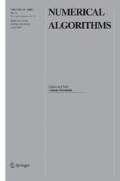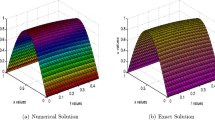Abstract
When the standard Chebyshev collocation method is used to solve a third order differential equation with one Neumann boundary condition and two Dirichlet boundary conditions, the resulting differentiation matrix has spurious positive eigenvalues and extreme eigenvalue already reaching O(N 5 for N = 64. Stable time-steps are therefore very small in this case. A matrix operator with better stability properties is obtained by using the modified Chebyshev collocation method, introduced by Kosloff and Tal Ezer [3]. By a correct choice of mapping and implementation of the Neumann boundary condition, the matrix operator has extreme eigenvalue less than O(N 4. The pseudospectral and modified pseudospectral methods are implemented for the solution of one-dimensional third-order partial differential equations and the accuracy of the solutions compared with those by finite difference techniques. The comparison verifies the stability analysis and the modified method allows larger time-steps. Moreover, to obtain the accuracy of the pseudospectral method the finite difference methods are substantially more expensive. Also, for the small N tested, N ⩽ 16, the modified pseudospectral method cannot compete with the standard approach.
Similar content being viewed by others
References
C. Canuto, M.Y. Hussaini, A. Quarteroni and T.A. Zang,Spectral Methods in Fluid Dynamics (Springer, Berlin, 1988).
B. Fornberg, A Practical Guide to Pseudospectral Methods, Cambridge Monographs on Applied and Computational Mathematics (Cambridge University Press, Cambridge, 1996).
D. Kosloff and H. Tal Ezer, ModifiedChebyshev pseudospectral method with O(N-1) time step restriction, J. Comput. Phys. 104 (1993) 457–469.
W.J. Merryfield and B. Shizgal,Note: properties of collocation third-derivative operators, J. Comput. Phys. 105 (1993) 182–185.
L.S. Mulholland, The eigenvalues ofthird-order Chebyshev pseudospectral differentiation matrices, Preprint, Mathematics Report No. 6, University of Strathclyde, UK (1995).
S.C. Reddy and L.N. Trefethen, Stability of the method of lines, Numer.Math. 62 (1992) 235–267.
R. Renaut and J. Fröhlich,A pseudospectral Chebyshev method for the 2D wave equation with domain stretching and absorbing boundary conditions, J. Comput. Phys. 124 (1996) 324–326.
B.D. Welfert, A remark on pseudospectral differentiation matrices,SIAM J. Numer. Anal., to appear.
Author information
Authors and Affiliations
Rights and permissions
About this article
Cite this article
Renaut, R., Su, Y. Evaluation of Chebyshev pseudospectral methods for third order differential equations. Numerical Algorithms 16, 255–281 (1997). https://doi.org/10.1023/A:1019199416310
Issue Date:
DOI: https://doi.org/10.1023/A:1019199416310



